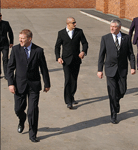
En Garde
Despite their Hollywood mainstream image, bodyguards do much more behind the scenes to protect us than we know.
- By Marc Barrera
- Nov 03, 2009
The popular image of a bodyguard is someone 3-feet thick wearing a black suit and tie, impenetrable sunglasses, and whispering into a wrist phone. Thanks to Hollywood, many of us immediately picture Kevin Costner carrying Whitney Houston through an unruly crowd of fans, but nothing could be further from the truth. A true professional does the majority of his work ahead of time, planning every location and every possible scenario, and avoiding the things that cannot be controlled--basically, doing everything possible to avoid ever being in any situation that would require Costner's heroics.
"The typical Hollywood bodyguard is an oversized, overweight, useless product. They have no understanding for the academics of a proper advance and typically are not prepared for a real attack on their client. They are a walking billboard for the incompetent."
"Of most importance is the 'advance' work," said John Nobriga, owner of Lodi, Calif.-based JMN Investigations. "This is a preliminary process that involves plotting various routes to each location so that the protection agent can vary his or her driving patterns. The purpose of this process is to prevent a threat from identifying these routes and attempting an ambush on our client. Ninety percent of the organized assassinations take place in this fashion."
Training
Typically, you doesn't start out as a bodyguard. Rather, professionals who get into the field are ex-military or ex-law enforcement professionals. Within those areas, Nobriga said he looks to recruit those with similar work experience, such as Secret Service, diplomatic security, or protective escorts. But some do get into the business through specialized training from private "executive protection" schools, such as Executive Security International (ESI) or R.L. Oatman & Associates Inc.
It's also a good idea to receive this additional training through these schools even if you come from a military or law enforcement background. As Nobriga pointed out, in order to stay in top form, a professional bodyguard must constantly hone his skills. "Training is a never-ending requirement," he said. "The threat is a living,breathing monster, which always evolves and makes necessary adjustments to achieve their stated goals. We, too, must adjust, modify, and prepare for these changes."
Many industry associations promote best practices and standards. Nobriga said he recommends the Association of Th reat Assessment Professionals in particular. "ATAP is essentially a think tank for government and private-sector companies," he said. "It is a closed-membership-based organization, meaning you must be sponsored by an existing member to be considered for membership. The academics of this trade are the essence of this organization. Regular training and participation is a requirement for continued membership."
In addition to training, each state has its own licensing policies for security agencies, as well as state guard registrations and firearm permit requirements. Nobriga also recommended any agency should carry at least $2 million in liability insurance, along with adequate medical and worker's compensation coverage.
Tools of the Trade
A bodyguard's safety is secondary to the safety of the client. Still, many tools allow bodyguards to minimize the risk to themselves. Bodyguards can wear body armor, use armored vehicles, and employ any number of lethal and non-lethal weapons. None of these can replace their most valuable tools: knowledge, preparation, and teamwork.
"The key to understanding your adversary and preparing for their capabilities is to study their history and understand their techniques," Nobriga said. "A strong network of other professionals will allow the successful agency to staff all client movements, in all states and international territories, with the appropriate levels of coverage."
Despite the prep work to avoid any possible harm, bodyguards often must place themselves in harm's way to protect their clients. At these critical moments, the value of a good team and preparedness becomes evident. "By our very nature, we are a high-risk group. We take a high-profile, high-risk client and attempt to manage movements without compromising our client's safety," Nobriga said. "During an evacuation and potential threat engagement, we will address our adversary with any means available. This includes the use of our own bodies to provide cover for our client while the remaining team initiates the evacuation."
Shop Around
For the client, selecting the right personal security provider is a critical decision. There are hundreds of organizations and thousands of freelance professionals of varying competency levels seeking employment. This makes proper vetting essential. A good idea is to get a reference from a training school or related association. "In this industry, there are many 'cowboys' who can place a client at great risk," Nobriga said. "The typical Hollywood bodyguard is an oversized, overweight, useless product. They have no understanding for the academics of a proper advance and typically are not prepared for a real attack on their client. They are a walking billboard for the incompetent."
This article originally appeared in the November 2009 issue of Occupational Health & Safety.